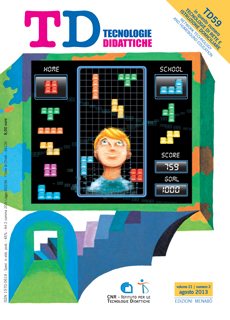Aggiornamento per insegnanti di sostegno
Main Article Content
Abstract
Article Details
Authors who publish with this journal agree to the following terms:
- Authors retain copyright and grant the journal right of first publication with the work simultaneously licensed under a Creative Commons CC BY 4.0 Attribution 4.0 International License.
- Authors are able to enter into separate, additional contractual arrangements for the non-exclusive distribution of the journal's published version of the work (e.g., post it to an institutional repository or publish it in a book), with an acknowledgement of its initial publication in this journal.
- Authors are permitted and encouraged to post their work online (e.g., in institutional repositories or on their website) prior to and during the submission process, as it can lead to productive exchanges, as well as earlier and greater citation of published work (See The Effect of Open Access)
References
Albanese O., Conenna G., De Marco B., Garavaglia A., Petti L., Mercadante L., Calligaris L., Aloisi T. (2011). La formazione all’inclusione degli insegnanti di sostegno con Wiki e Forum. TD-Tecnologie Didattiche, 52, 19 (1), pp. 4-11.
Banzato M. (2006). Blog e didattica. TD-Tecnologie Didattiche, 38, 14 (2), pp. 23-31.
Cappa C., Grosso L., Rossi V., Albanesi E., Guglielmino P., Muzio C., Damiani P. (2012). Alunni speciali. Non solo dislessia. Novara, IT: DeAgostini scuola,.
Cross J. (2006). Informal Learning: Redescovering the natural pathways that inspire innovation and performance. San Francisco, CA, USA: Pfeiffer - John Wiley & Sons.
Dini S., Mesiti M., Ribaudo M. (2011). VisualPedia: Wiki per la didattica a supporto di studenti con diverse forme di disabilità. TD-Tecnologie Didattiche, 52, 19 (1), pp. 43-48.
Ferlino L., Oliva L., Caruso G.P. (2010). WikiMindMap, uno strumento versatile per la didattica. TD-Tecnologie Didattiche, 50, 18 (2), pp. 59-61.
Fini A. (2006). Schede tecniche e glossario. In G. Bonaiuti (ed.). E-learning 2.0. Il futuro dell’apprendimento in rete tra formale e informale. Trento, IT: Erickson.
Garavaglia A., Ferrari S. (2006). Strumenti. In C. Rivoltella (ed.). E-tutor.Profilo, metodi, strumenti. Roma: Carocci.
Petrucco C. (2003). Ricercare in Rete. Lecce, IT: Pensa Multimedia.
Petrucco C. (2006). Software sociali per un apprendimento aperto e flessibile in Rete. In F. Faiella (2006), I percorsi ed i processi della didattica multimediale. Lecce, IT: Pensa Multimedia.
Petrucco C., Campion M. (2009). Progetto Didaduezero: una ricerca-azione per favorire i rapporti tra scuola e territorio con strumenti del web 2.0. TD-Tecnologie Didattiche, 48, 17 (3), pp. 47-54.
Siemens G. (2004). Connectivism: A learning theory for the digital age. ElearnSpace http://www.elearnspace.org/Articles/connectivism.htm
(ultima consultazione 31.05.2013).
Siemens G. (2006). Knowing Knowledge. Elearnspace,
http://www.elearnspace.org/KnowingKnowledge_LowRes.pdf
(ultima consultazione 31.05.2013).
Trentin G. (2007). I wiki nell’organizzazione e nella valutazione del c-learning. TD-Tecnologie Didattiche, 42, 15 (3), pp. 4-14.

